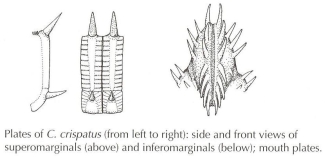Ctenodiscus crispatus is a small sea star, with a soft, slightly inflated aboral surface bearing a characteristic elevated cone in the centre (epiproctal cone). Five short triangular arms (exceptionally four or six) extend up to 5.4 cm long. The aboral side is grey to yellow-white, and the oral side is lighter with tinges of pale orange. The ratio of arm to disc is from 1.7 to 2.7. The paxillae of the aboral surface are low, with few to many short skin-covered spinelets. Each arm has a definite vertical side formed by 11 to 20 marginals. There is a single conical spine at the upper ends of the superomarginals and inferomarginals. Deep grooves between the marginals and across the oral intermediates are bordered on both sides by flat spinelets that extend over the furrow. The adambulacrals have an oblique series of 3 to 5 sharp furrow spines. The tube feet are large and pointed. The mouth plates are prominent, with 7 marginal spines; the apical spine is the largest.
Characteristics
Similar SpeciesNo other species has an elevated cone in the centre of the disc.
